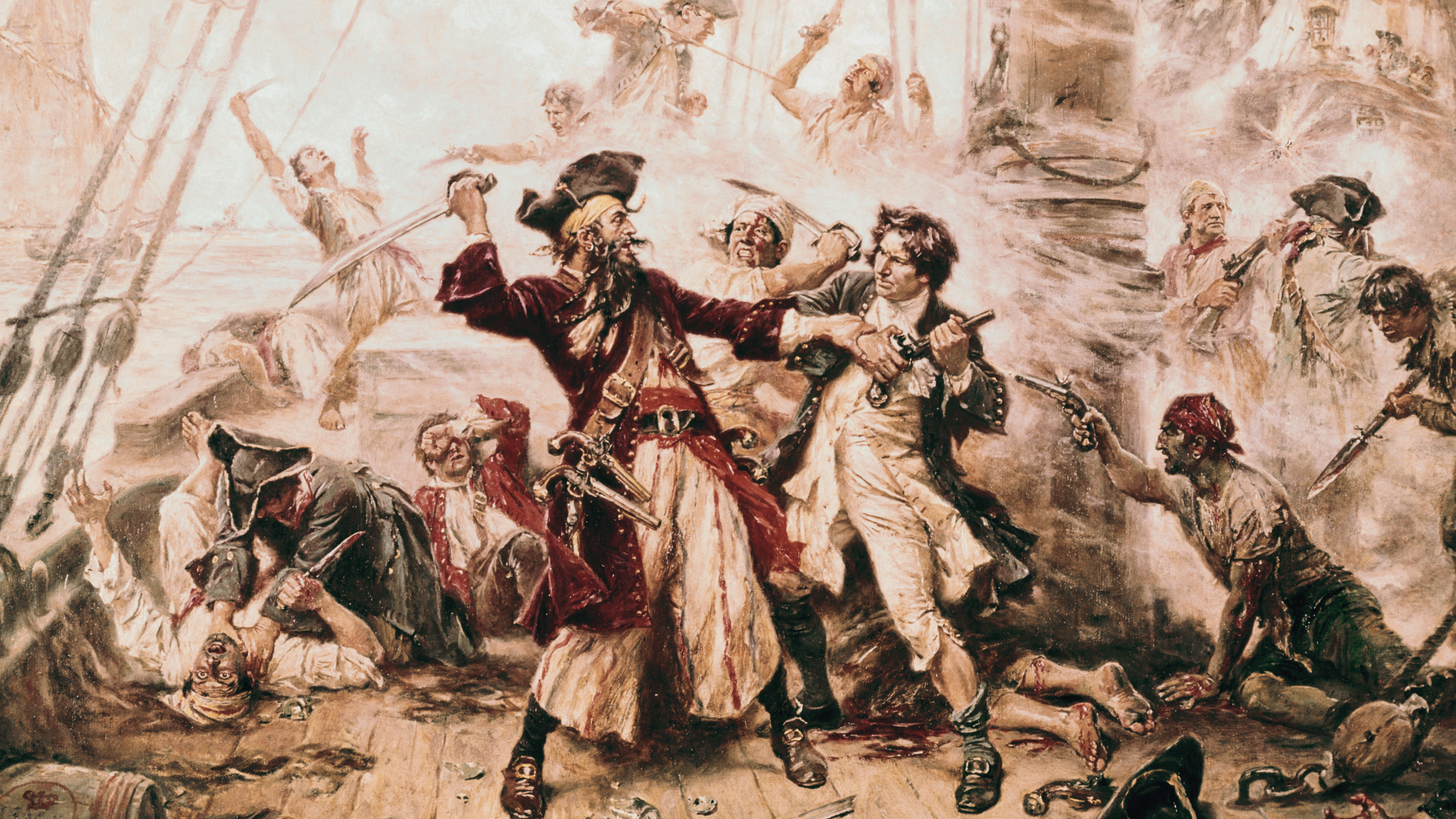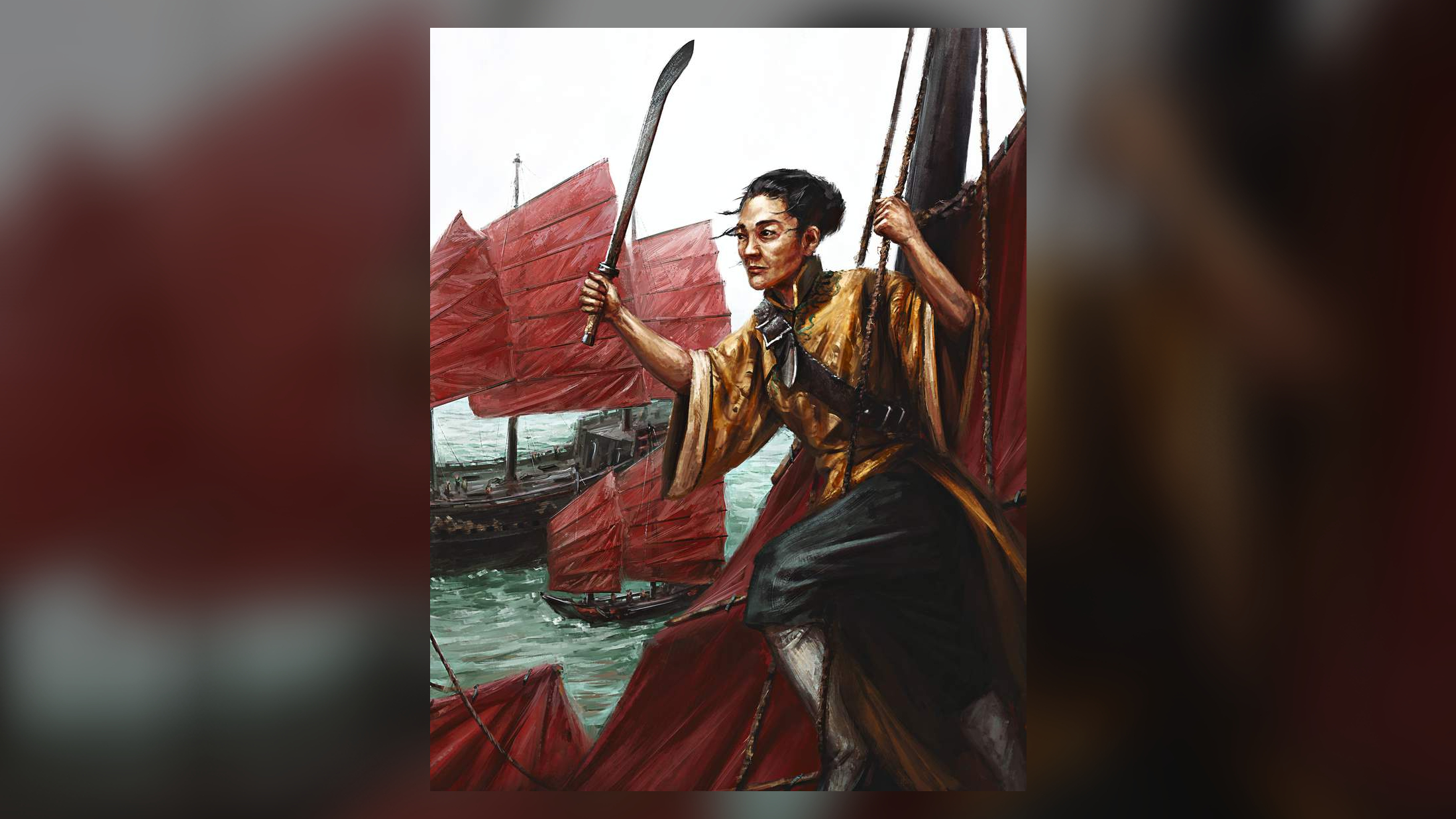10 of the most notorious pirates in history
The most notorious pirates wreaked havoc from China to the Caribbean. Here are 10 fearsome pirates from history.

The world’s most notorious pirates terrorized the seven seas and amassed huge riches between the 16th and 19th centuries. Many of these ship plunderers remain famous to this day, but they were very different from the often-friendly pirates seen in the "Pirates of the Caribbean" movie franchise.
Many of history's most famous pirates began as privateers — sailors-for-hire on private warships who had been given permission to attack their country's enemies at sea and harass commercial ships in designated zones. Some of these privateers also targeted ships from their own nation when the lure of gold was too great, and they struck out under their own flag to illegally raid merchant vessels.
Some pirates were so successful they became feared around the world and made millions of dollars by today's standards. Here are 10 of the most notorious pirates of all time.
1. Blackbeard

Blackbeard is possibly the most famous pirate in history, but his life is shrouded in mystery. Much of what we know about him and other pirates of his time comes from a 1724 book, published under the name Capt. Charles Johnson, called "A General History of the Pyrates." Charles Johnson is a pseudonym, and the book is often attributed to author Daniel Defoe, who wrote famous novels such as "Robinson Crusoe." Some of the book is backed up by government documents from the time, while scholars have proven other parts to be false, so it isn't an entirely reliable source.
The book says Blackbeard’s real name was Edward Thatch. He was born in Bristol, England and served as a privateer during the War of the Spanish Succession (1701 to 1714). In 1716, he turned to pirating in the Caribbean Sea and off the coasts of South Carolina and Virginia in his ship, Queen Anne's Revenge. He earned during the Golden Age of Piracy (around 1650 to 1720) a fearsome reputation, which, according to historian and journalist Colin Woodard, Blackbeard used to his advantage. "He did his best to cultivate a terrifying image and reputation, which encouraged his foes to surrender without a fight," Woodard told All About History magazine.
"A General History of the Pyrates" claimed that Thatch's huge beard "came up to his eyes," and while in action, he carried "three brace of pistols, hanging in holsters like Bandoliers; and stuck lighted matches under his hat" to cloud himself in an ominous haze of smoke. Blackbeard was killed in November 1718 after his ship was ambushed by the British navy near Ocracoke Island in North Carolina, according to the National Park Service.
Related: Abandon ship! 18th-century pirate Blackbeard deliberately grounded his leaky boat
Sign up for the Live Science daily newsletter now
Get the world’s most fascinating discoveries delivered straight to your inbox.
2. Ching Shih

One of the most successful pirates in history was a woman named Ching Shih, sometimes called Cheng I Sao or Zheng Yi Sao. Born into poverty as Shih Yang in Guangzhou, China, in the late 18th century, Shih was a sex worker until she married a pirate named Ching I in 1801 and took the name Ching Shih, which meant "the wife of Ching," according to a case study by the University of Oxford's Global History of Capitalism project.
The pair consolidated control of the region's rival pirate gangs into a confederation, Dian Murray, a professor emeritus of history at the University of Notre Dame in Indiana, wrote in a 1981 article in the journal Historical Reflections. Ching died in 1807, and Shih seized sole control of the pirate confederation. According to Murray, Shih secured control of the pirates through careful alliances and a strict code of laws. "The code was severe. Anyone caught giving commands on his own or disobeying those of a superior was immediately decapitated," Murray wrote.
At the height of her power, Shih, also called the "Pirate Queen," controlled a fleet of 1,200 ships crewed by about 70,000 pirates. Shih broke up the confederation in 1810 and negotiated a generous surrender deal with the Chinese government. Not only were the pirates pardoned for their crimes, but some were allowed to keep their vessels and joined the Chinese navy. Some even took positions in the government, Murray wrote.
Related: Famous women in history: 10 influential women from around the world
3. Sir Francis Drake

Sir Francis Drake was a noble to some and an outlaw pirate to others. Born in Devon, England, around 1540, Drake became the first person from England to circumnavigate the globe, according to the BBC — although this feat was not a planned exploration but rather a byproduct of his goal to raid Spanish ships in the Americas.
Drake's exploits were legitimate from an English perspective because the Spanish had claimed the entire New World territory and the English wanted in, but to the Spanish, Drake was a menacing pirate thief they nicknamed "El Draque," or “the Dragon,” Elaine Murphy, an associate professor of maritime and naval history at the University of Plymouth in England, wrote in an article on the university’s website. Drake brought back plenty of treasure from his circumnavigation and shared his riches with Queen Elizabeth I. He was also a leading naval commander who fought against the Spanish Armada, a huge fleet of Spanish ships that was part of a failed attempt to invade England and overthrow the queen in 1588.
Drake's legacy is further muddied by his involvement in slavery. He helped start the English slave trade in Africa by making multiple trips to Guinea and Sierra Leone with his cousin and naval commander Sir John Hawkins and enslaved up to 1,400 African people, according to Murphy. Drake died of dysentery off the coast of Panama in 1596.
Related: Colombia moves to salvage immense treasure from sunken Spanish galleon
4. Black Sam Bellamy

Samuel Bellamy lived to be only 28 years old, but he made a name for himself during his short life. Likely born in Devon at the end of the 17th century, Bellamy began working on the high seas at the beginning of the War of the Spanish Succession when he was 13 years old and later became a pirate captain, according to the New England Historical Society.
As a pirate, Bellamy captured 53 ships, including the Whydah Gally, a slave ship carrying a fortune in gold, silver and other goods. The Whydah Gally had left England in 1716 and took 312 enslaved people from the west coast of Africa to Jamaica. Bellamy captured the ship as it returned to England, by then emptied of slaves and filled with profits, according to the Field Museum in Chicago.
He was likely the highest-earning pirate of all time, Forbes reported in 2008. Forbes estimated that he captured booty worth about $120 million in 2008 dollars. Bellamy made the Whydah Gally his flagship in 1717, but he went down with it in a storm that same year.
His nickname was "Black Sam" Bellamy because he wore black wigs tied back with a black bow. Bellamy also styled himself as the "Robin Hood of the Sea" by stealing from the wealthy. According to the New England Historical Society, he ran his ship democratically, treated his crew members as equals and spared the lives of captives.
Related: Sunken 17th-century 'pirate ship' discovered, alongside gunpowder-packed grenades
5. Black Bart

Bartholomew Roberts, nicknamed "Black Bart," was a tall, handsome and flamboyantly dressed 18th-century pirate from Wales. He initially worked on merchant ships but became a pirate and was soon elected captain of his own ship and crew, according to the Royal Museums Greenwich in London.
Roberts took upward of 400 ships during his lifetime, including in the Caribbean and off the coast of Africa. He often took slave ships and then demanded gold from their captains in exchange for their return. When one such captain refused, Roberts reportedly burned the ship with 80 enslaved people trapped on board, according to the World History Encyclopedia.
Black Bart's crimes came to an end in 1722 when he was killed by the British navy off the coast of Gabon in West Central Africa while his crew members were too drunk to defend the ship, according to the Royal Museums Greenwich. A total of 52 members of his crew were then hanged following the largest pirate trial ever held, according to the Smithsonian's National Museum of Natural History in Washington, D.C.
Related: Why did pirates wear earrings?
6. Captain Kidd

William Kidd, often known as Captain Kidd, is famous for walking the blurry line between privateer and pirate. Born in Scotland around 1645, Kidd was employed as a privateer by the British government in 1689 and was even commissioned to arrest pirates. However, he was ultimately hanged for murder and piracy himself, according to Britannica.
Kidd famously captured a merchant ship, the Quedagh Merchant, off the west coast of India in 1698. The ship was filled with gold, silver, valuable silks and satins, as well as other Indian merchandise. Learning he'd been branded a pirate, Kidd left the ship in the Caribbean in 1699, traveled to New York to clear his name and was captured. The wreckage of the Quedagh Merchant was discovered in 2007.
Historians disagree on whether Kidd was actually guilty of piracy. Nevertheless, he was executed in London in 1701. Authorities then hung his body in a metal cage in the River Thames for three high tides, supposedly to deter passing sailors from piracy, according to Thurrock Council, a local government authority in England.
Related: Buccaneer bones: Possible pirate skeleton found under Scotland schoolyard
7. Sir Henry Morgan

Rum drinkers will be familiar with Sir Henry Morgan — his portrait appears on the front of "Captain Morgan" rum bottles. Morgan was born in Wales in around 1635 and went to the Caribbean as a laborer in 1655. Completing his contracted work in Barbados, Morgan sought his fortunes in Jamaica and quickly turned to piracy, according to the Dictionary of Welsh Biography (DWB).
Morgan married his cousin Elizabeth Morgan in 1665, who was also the daughter of the deputy-governor of Jamaica. From 1666, he commanded his own ship as a privateer. Morgan fought on land as well as at sea. He raided towns along the coasts of Mexico, Panama and Cuba, according to BBC Wales. His bounty included gold, silver and gems, and he also captured and sold enslaved people. Morgan appears to have been knighted by King Charles II of England in 1674, despite being a prisoner for his exploits just a few years earlier, according to the DWB. This demonstrates how quickly fortunes could change for pirates and privateers during the Golden Age of Piracy.
Morgan died of natural causes in 1688. At the time of his death, Morgan owned three plantations, and his estate in Jamaica had 131 enslaved people, including 33 boys, girls or children, according to the Legacies of British Slavery database at University College London.
Related: What happened to the lost Pirate Republic?
8. Anne Bonny

Anne Bonny (or Bonney) was a female pirate who was as menacing as her male counterparts, if not more so. The daughter of a plantation owner, Bonny was born in Ireland in 1698 before moving to South Carolina, according to the Royal Museums Greenwich. She left her life behind for the Caribbean in the early 1700s and hit the open ocean. Bonny started pirating disguised as a man on the ship of Calico Jack Rackham, a pardoned buccaneer.
9. Mary Read

Bonny wasn’t alone in her piracy: She had a partner, Mary Read, who was also part of Rackham’s crew. Read was born in London and also dressed as a man. She was working on another ship when it was captured by Rackham, and so she joined Rackham’s crew.
Bonny and Read became friends, pillaging together on the high seas. They wore jackets and long trousers, and fought with a machete in one hand and a pistol in the other. A victim of their piracy testified that they were very active on the ship and "wiling to do any thing," according to Smithsonian Magazine.
Rackham's ship and crew were captured off Jamaica in 1720 and put on trial, but Bonny and Read avoided the gallows because they were both pregnant. Read died in prison with a fever, while Bonny survived. Her father secured her release from prison and took her back to South Carolina, where she lived until age 84.
Related: Pirate attacks linked to destructive fishing
10. Charles Vane

Charles Vane is a mysterious figure in the Golden Age of Piracy. His date and place of birth are unknown, but historical accounts paint him as a bold and ruthless pirate. He's first recorded in the early 18th century, plundering Spaniards who were salvaging silver from the wreckage of a Spanish fleet in the Gulf of Florida, according to the Oxford Dictionary of National Biography. From there, he's documented attacking various ships on the high seas.
Once, when he was cornered by the British navy, Vane set fire to his flagship vessel and sent it directly into the British fleet. The burning ship caused a sufficient distraction for Vane to escape and avoid capture, according to The National Archives in London, a U.K. government department. Vane’s crew eventually removed him from command of his pirate ships, and he was stranded on an uninhabited island in the Caribbean after a storm ruined his only remaining vessel. He was rescued but soon identified and hanged for his crimes in Jamaica in 1721.
Vane wasn't the richest pirate, but he still amassed the equivalent of $2.3 million by the end of his career, based on a 2008 estimation reported by Forbes..
Related: Sunken pirate ship from explorer Vasco da Gama's fleet discovered
Additional resources
Learn more about the real Caribbean pirates by reading Colin Woodard's "The Republic of Pirates: Being the True and Surprising Story of the Caribbean Pirates and the Man Who Brought Them Down" (Mariner Books, 2008). You can also listen to a short audio series about historical pirates called "The Truth About Pirates," by Royal Museums Greenwich, on SoundCloud. For more information on the discovery of Captain Kidd's ship, the Quedagh Merchant, check out the Indiana University website.

Patrick Pester is the trending news writer at Live Science. His work has appeared on other science websites, such as BBC Science Focus and Scientific American. Patrick retrained as a journalist after spending his early career working in zoos and wildlife conservation. He was awarded the Master's Excellence Scholarship to study at Cardiff University where he completed a master's degree in international journalism. He also has a second master's degree in biodiversity, evolution and conservation in action from Middlesex University London. When he isn't writing news, Patrick investigates the sale of human remains.









